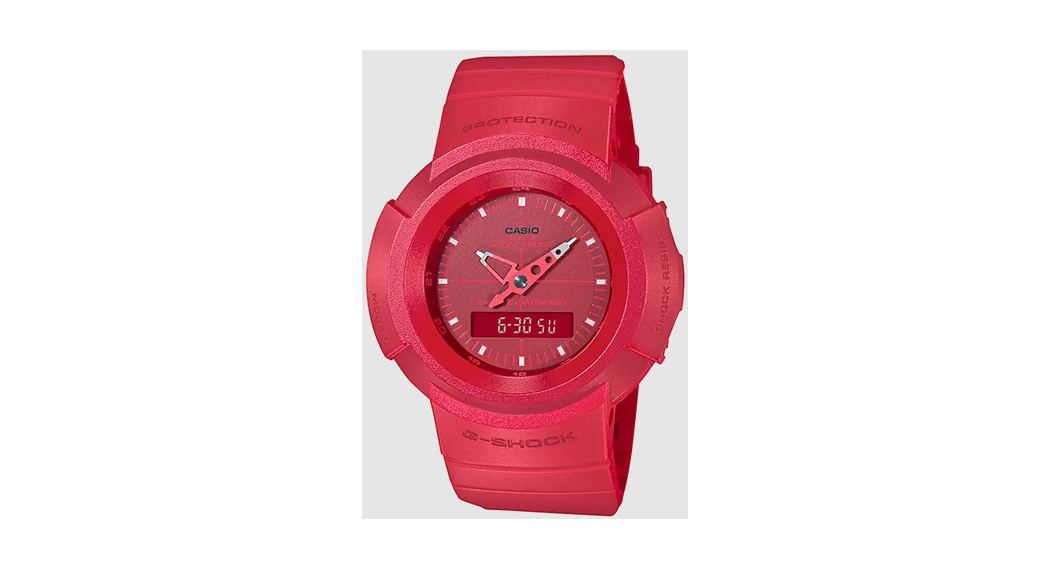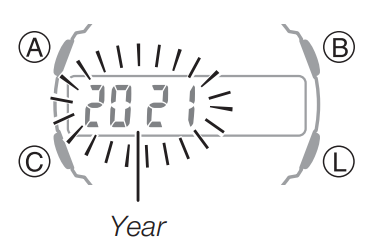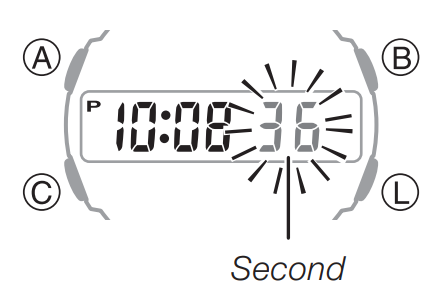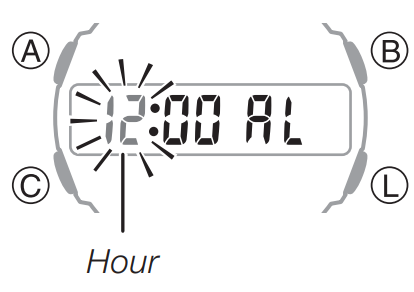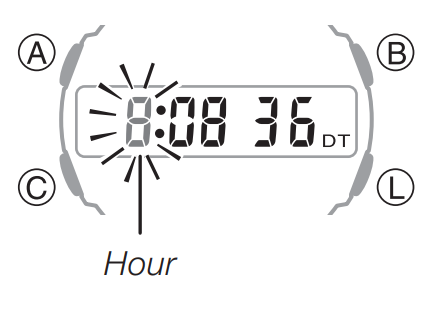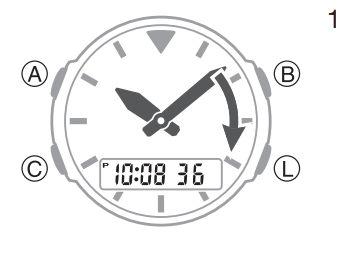
MA2009-EA© 2020 CASIO COMPUTER CO., LTD.
Operation Guide 5416Congratulations upon your selection of this CASIO watch.To ensure that this watch provides you with the years of service for which it is designed, carefully read and follow the instructions in this manual, especially the information under “Operating Precautions” and “User Maintenance”.
About This Manual
- Depending on the model of your watch, display text appears either as dark figures on a light background, or light figures on a dark background. All sample displays in this manual are shown using dark figures on a light background.
- Button operations are indicated using the letters shown in the illustration.
- Note that the product illustrations in this manual are intended for reference only, and so the actual product may appear somewhat different than depicted by an illustration.
 |
 |
Things to check before using the watch
1. Set the current time. x See “Adjusting the Date Setting” (page E-11) and “Adjusting the Digital Time Setting” (page E-13).The watch is now ready for use.
Mode Reference Guide
The mode you should select depends on what you want to do.
| To do this: | Enter this mode: | See: |
|
||
|
Calendar ModeTimekeeping Mode | E-11
E-13 |
|
||
| Set an alarm time | Alarm Mode | E-15 |
| Use the stopwatch to measure elapsed time | Stopwatch Mode | E-17 |
| Set the dual time | Dual Time Mode | E-19 |
Selecting a Mode
- Press © to cycle between the modes as shown below. Press Q to illuminate the display.
- In any mode (except when a setting mode. with flashing digits is on the display).

General Functions (All Modes)The functions and operations described in this section can be used in all of the modes.Auto Return FeaturesIf you leave a setting mode with flashing digits on the display for two or three minutes without performing any operation, the watch exits the setting mode automatically.ScrollingThe © button is used on the setting mode to scroll through data on the display. In most cases, holding down this button during a scroll operation scrolls through the data at high speed.
Adjusting the Date Setting
Use the procedure below to adjust the date setting.Note
- You can specify a date in the range of January 1, 2000, to December 31, 2099.
- The watch’s built-in full automatic calendar makes allowances for different month lengths and leaps years. Once you set the date, there should be no reason to change it except after you have the watch’s battery replaced.
- The day of the week changes automatically when the date changes.
To configure the date setting
- In the Calendar Mode, hold down B for at least two seconds until the year starts to flash. This is the setting mode.
- Press B to move the flashing in the sequence shown below to select the other settings.


- When the date set you want to change is flashing, use ©to change it.
- Press B to exit the setting mode.
Adjusting the Digital Time Setting
Use the procedure below to adjust the digital time setting.
To configure the digital time setting
- In the Timekeeping Mode, hold down B for at least two seconds until the second starts to flash. This is the setting mode.
- Press B to move the flashing in the sequence shown below to select the other settings.


- When the timekeeping setting you want to change is flashing, use © to change it as described below.
Screen To do this: 
Reset the second to 00 
Change the hour or minute 
Toggle between 12-hour (12H) and 24-hour (24H) timekeeping - Press B to exit the setting mode.
Note
- While 12-hour format is selected for timekeeping, a P indicator will appear fortimes from noon to 11:59 p.m. No indicator appears for times from midnight to 11:59 a.m. With the 24-hour format, time is displayed from 0:00 to 23:59, without any P indicator.
Using the Alarm
When an alarm is turned on, the alarm tone will sound when its alarm time is reached.
To enter the Alarm ModeUse © to select the Alarm Mode as shown on page E-9.To set an alarm time Hour
- In the Alarm Mode, hold down B for at least two seconds until the hour starts to flash. This is the setting mode.
- Press B to move the flashing between the hour and minute settings.
- While a setting is flashing, use © to change it. x When setting the alarm time using the 12-hour format, take care to set the time correctly as a.m. (no indicator) or p.m. (P indicator).
- Press B to exit the setting mode.

To test the alarmIn any mode, hold down © to sound the alarm.To turn an alarm on and offIn the Alarm Mode, each press of B toggles between on and off.

To stop the alarmPress any button.
Using the Stopwatch
The stopwatch measures elapsed time.
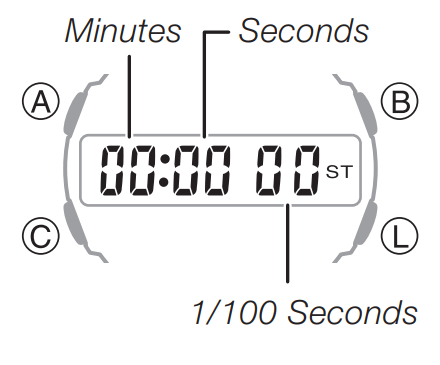
To enter the Stopwatch Mode Use © to select the Stopwatch Mode as shown on page E-9.
To perform an elapsed time operation
Note
- The Stopwatch Mode can indicate elapsed time up to 23 hours, 59 minutes, 59 seconds.
- After the elapsed time reaches one hour, the display units change to hours, minutes, and seconds, and time is measured in one-second increments.
Dual Time Mode
You can use the Dual Time Mode to set a second time that is different from the Timekeeping Mode time.To enter the Dual Time ModeUse © to select the Dual Time Mode as shown on page E-9.To set the Dual Time
- In the Dual Time Mode, hold down B for at least two seconds until the hour starts to flash. This is the setting mode.
- Press B to move the flashing between the hour and minute settings.
- While a setting is flashing, use © to change it. x While the 12-hour format is selected for digital timekeeping, a P (PM) indicator will appear for times from noon to 11:59 p.m.
- Press B to exit the setting mode. x In the Dual Time Mode, the second’s count is synchronized with the second’s count of the digital timekeeping.

Adjusting the Analog Hand Setting
Use the following procedure to adjust the analog hands so their settings match the digital time.To adjust the analog time
- In any mode, press A to advance the analog time setting by 20 seconds.• Holding down A advances the analog time setting at high speed.

Illumination
The face of the watch is illuminated for easy reading in the dark.To turn on illuminationIn any mode (except when a setting mode, with flashing digits, is on the display), press L to illuminate the display.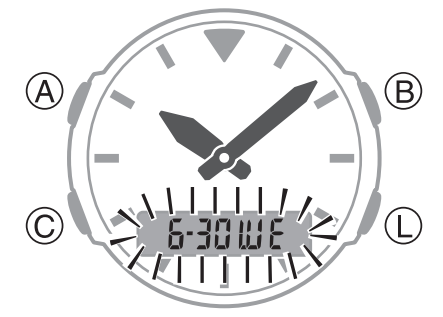
Illumination Precautions
- Illumination may be hard to see when viewed under direct sunlight.
- Illumination turns off automatically whenever an alarm sounds.
- Frequent use of illumination runs down the battery.
- The watch will emit an audible sound whenever the display is illuminated. This is caused by a transistor that vibrates when the EL panel lights up. It does not indicate the malfunction of the watch.
Specifications
Accuracy at normal temperature: ±15 seconds a month Calendar: Month, day, day of the weekCalendar System: Full Auto-calendar pre-programmed from the year 2000 to 2099Digital Timekeeping: Hour, minute, second, p.m. (P) Time format: 12-hour and 24-hourAnalog Timekeeping: Hour, minute (hand moves every 20 seconds)Alarm: Setting units: Hour, minute Beeper: 20 secondsStopwatch:Measuring unit: 1/100 second (1 second after 1 hour)Measuring capacity: 23:59’59”Measuring mode: Elapsed timeDual Time: Hour, minute, secondIllumination: EL (electro-luminescent) backlight
Battery:One lithium battery (Type: CR2016) Approximately 7 years on type CR2016 (assuming alarm operation 20 seconds per day and one illumination operation 2 seconds per day) Frequent use of illumination runs down the battery.Specifications are subject to change without notice.
Operating Precautions
Water Resistance
- The information below applies to watches with WATER RESIST or WATER RESISTANT marked on the back cover.
| Water ResistanceUnder Daily Use | Enhanced Water Resistance Under Daily Use | ||||
| 5Atmospheres | 10Atmospheres | 20Atmospheres | |||
| Marking | On watch front or onback cover | NoBAR mark | 5BAR | 10BAR | 20BAR |
| Example ofDaily Use | Hand washing, rain | Yes | Yes | Yes | Yes |
| Water-related work, swimming | No | Yes | Yes | Yes | |
| Windsurfing | No | No | Yes | Yes | |
| Skin diving | No | No | Yes | Yes |
- Do not use your watch for scuba diving or other types of diving that requires air tanks.
- Watches that do not have WATER RESIST or WATER RESISTANT marked on the back cover are not protected against the effects of sweat. Avoid using such a watch under conditions where it will be exposed to large amounts of sweat or moisture, or to direct splashing with water.
- Even if a watch is water-resistant, note the usage precautions described below. Such types of use reduce water resistance performance and can cause fogging of the glass.– Do not operate the crown or buttons while your watch is submerged in water or wet.– Avoid wearing your watch while in the bath.– Do not wear your watch while in a heated swimming pool, sauna, or any other high temperature/high humidity environment.– Do not wear your watch while washing your hands or face, while doing housework, or while performing any other task that involves soaps or detergents.
- After submersion in seawater, use plain water to rinse all salt and dirt from your watch.
- To maintain water resistance, have the gaskets of your watch replaced periodically (about once every two or three years).
- A trained technician will inspect your watch for proper water resistance whenever you have its battery replaced. Battery replacement requires the use of special tools. Always request battery replacement from your original retailer or from an authorized CASIO service center.
- Some water-resistant watches come with fashionable leather bands. Avoid swimming, washing, or any other activity that causes direct exposure of a leather band to water.
- The inside surface of the watch glass may fog when the watch is exposed to a sudden drop in temperature. No problem is indicated if the fogging clears up relatively quickly. Sudden and extreme temperature changes (such as coming into an air-conditioned room in the summer and standing close to an air conditioner outlet, or leaving a heated room in the winter and allowing your watch to come into contact with snow) can cause it to take longer for glass fogging to clear up. If glass fogging does not clear up or if you notice moisture inside of the glass, immediately stop using your watch and take it to your original retailer or to an authorized CASIO service center.
- Your water-resistant watch has been tested in accordance with International Organization for Standardization regulations.
Band
- Tightening the band too tightly can cause you to sweat and make it difficult for airto pass under the band, which can lead to skin irritation. Do not fasten the band too tightly. There should be enough room between the band and your wrist so you can insert your finger.
- Deterioration, rust, and other conditions can cause the band to break or come off of your watch, which in turn can cause band pins to fly out of position or to fall out. This creates the risk of your watch falling from your wrist and becoming lost and also creates the risk of personal injury. Always take good care of your band and keep it clean.
- Immediately stop using a band if you even notice any of the following: loss of band flexibility, band cracks, band discoloration, band looseness, band connecting pin flying or falling out, or any other abnormality. Take your watch to your original retailer or to a CASIO service center for inspection and repair (for which you will be charged) or to have the band replaced (for which you will be charged).
Temperature
- Never leave your watch on the dashboard of a car, near a heater, or in any other location that is subject to very high temperatures. Do not leave your watch where it will be exposed to very low temperatures. Temperature extremes can cause your watch to lose or gain time, to stop, or otherwise malfunction.
- Leaving your watch in an area hotter than +60°C (140°F) for long periods can lead to problems with its LCD. The LCD may become difficult to read at temperatures lower than 0°C (32°F) and greater than +40°C (104°F).
Impact
- Your watch is designed to withstand impact incurred during normal daily use andduring light activity such as playing catch, tennis, etc. Dropping your watch or otherwise subjecting it to strong impact, however, can lead to malfunction. Note that watches with shock-resistant designs (G-SHOCK, BABY-G, G-MS) can be worn while operating a chain saw or engaging in other activities that generate strong vibration, or while engaging in strenuous sports activities (motocross, etc.)
Magnetism
- The hands of analog and combination (analog-digital) watches are moved by a motor that uses magnetic force. When such a watch is close to a device (audio speakers, magnetic necklace, cell phone, etc.) that emits strong magnetism, the magnetism can cause timekeeping to slow down, speed up, or stop, resulting in the incorrect time being displayed.
- Very strong magnetism (from medical equipment, etc.) should be avoided because it can cause malfunction of your watch and damage to electronic components.
Electrostatic Charge
- Exposure to a very strong electrostatic charge can cause your watch to display at the wrong time. A very strong electrostatic charge even can damage electronic components.
- Electrostatic charge can cause the display to go blank momentarily or cause a rainbow effect on the display.
Chemicals
- Do not allow your watch to come into contact with thinner, gasoline, solvents, oils, or fats, or with any cleaners, adhesives, paints, medicines, or cosmetics that contain such ingredients. Doing so can cause discoloration of or damage to the resin case, resin band, leather, and other parts.
Storage
- If you do not plan to use your watch for a long time, thoroughly wipe it free of all dirt, sweat, and moisture, and store it in a cool, dry place.
Resin Components
- Allowing your watch to remain in contact with other items or storing it together with other items for long periods while it is wet can cause the color on resin components to transfer to the other items, or the color of the other items to transfer to the resin components of your watch. Be sure to dry off your watch thoroughly before storing it and make sure it is not in contact with other items.
- Leaving your watch where it is exposed to direct sunlight (ultraviolet rays) for long periods or failure to clean dirt from your watch for long periods can cause it to become discolored.
- Friction caused by certain conditions (strong external force, sustained rubbing, impact, etc.) can cause discoloration of painted components.
- If there are printed figures on the band, strong rubbing of the printed area can cause discoloration.
- Leaving your watch wet for long periods can cause the fluorescent color to fade. Wipe the watch dry as soon as possible after it becomes wet.
- Semi-transparent resin parts can become discolored due to sweat and dirt, and if exposed to high temperatures and humidity for long periods.
- Daily use and long-term storage of your watch can lead to deterioration, breaking, or bending of resin components. The extent of such damage depends on usage conditions and storage conditions.
Leather Band
- Allowing your watch to remain in contact with other items or storing it together with other items for long periods while it is wet can cause the color of the leather band to transfer to the other items or the color of the other items to transfer to the leather band. Be sure to dry off your watch thoroughly with a soft cloth before storing it and make sure it is not in contact with other items.
- Leaving a leather band where it is exposed to direct sunlight (ultraviolet rays) for long periods or failure to clean dirt from a leather band for long periods can cause it to become discolored.CAUTION: Exposing a leather band to rubbing or dirt can cause color transfer and discoloration.
Metal Components
- Failure to clean dirt from metal components can lead to the formation of rust, even if components are stainless steel or plated. If metal components are exposed to sweat or water, wipe thoroughly with a soft, absorbent cloth and then place the watch in a well-ventilated location to dry.
- Use a soft toothbrush or similar tool to scrub the metal with a weak solution of water and a mild neutral detergent, or with soapy water. Next, rinse with water to remove all remaining detergent and then wipe dry with a soft absorbent cloth. When washing metal components, wrap the watch case with kitchen plastic wrap so it does not come into contact with the detergent or soap.
Bacteria and Odor Resistant Band
- The bacteria and odor resistant band protects against odor generated by the formation of bacteria from sweat, which ensures comfort and hygiene. In order to ensure maximum bacteria and odor resistance, keep the band clean. Use an absorbent soft cloth to thoroughly wipe the band clean of dirt, sweat, and moisture. A bacteria and odor-resistant band suppress the formation of organisms and bacteria. It does not protect against rash due to allergic reactions, etc.
Liquid Crystal Display
- Display figures may be difficult to read when viewed from an angle.
Note that CASIO COMPUTER CO., LTD. assumes no responsibility for any damage or loss suffered by you or any third party arising through the use of your watch or its malfunction.
User Maintenance
Caring for Your WatchRemember that you wear your watch next to your skin, just like a piece of clothing. To ensure your watch performs at the level for which it is designed, keep it clean by frequently wiping it with a soft cloth to keep your watch and band free of dirt, sweat, water, and other foreign matter.
- Whenever your watch is exposed to seawater or mud, rinse it off with clean fresh water.
- For a metal band or a resin band with metal parts, use a soft toothbrush or similar tool to scrub the band with a weak solution of water and a mild neutral detergent, or with soapy water. Next, rinse with water to remove all remaining detergent and then wipe dry with a soft absorbent cloth. When washing the band, wrap the watch case with kitchen plastic wrap so it does not come into contact with the detergent or soap. x For a resin band, wash with water and then wipe dry with a soft cloth. Note that sometimes a smudge-like pattern may appear on the surface of a resin band. This will not have any effect on your skin or clothing. Wipe with a cloth to remove the smudge pattern.
- Clean water and sweat from a leather band by wiping with a soft cloth.
- Not operating a watch crown, buttons, or rotary bezel could lead to later problems with their operation. Periodically rotate the crown and rotary bezel, and press buttons to maintain proper operation.
Dangers of Poor Watch Care Rust
- Though the metal steel used for your watch is highly rust-resistant, rust can form if your watch is not cleaned after it becomes dirty.– Dirt on your watch can make it impossible for oxygen to come into contact with the metal, which can lead to the breakdown of the oxidization layer on the metal surface and the formation of rust.
- Rust can cause sharp areas on metal components and can cause band pins to fly out of position or to fall out. If you ever notice any abnormality immediately stop using your watch and take it to your original retailer or to an authorized CASIO service center.
- Even if the surface of the metal appears clean, sweat and rust in crevasses can soil the sleeves of clothing, cause skin irritation, and even interfere with watch performance.
Premature Wear
- Leaving sweat or water on a resin band or bezel, or storing your watch in an area subject to high moisture can lead to premature wear, cuts, and breaks.
Skin Irritation
- Individuals with sensitive skin or in poor physical condition may experience skin irritation when wearing a watch. Such individuals should keep their leather band or resin band particularly clean. Should you ever experience a rash or other skin irritation, immediately remove your watch and contact a skincare professional.
Battery Replacement
- Leave battery replacement up to your original retailer or authorized CASIO service center.
- Have the battery replaced only with the type specified in the User’s Guide. The use of a different battery type can cause malfunction.
- When replacing the battery, also request a check for proper water resistance.
- Ornamental resin components may become worn, cracked, or bent over time when subjected to normal daily use. Note that if cracking or any other abnormality indicating possible damage is noticed in a watch submitted for battery replacement, your watch will be returned with an explanation of the abnormality, without the requested servicing being performed.
Initial Battery
- The battery that comes loaded in your watch when you purchase it is used for function and performance testing at the factory.
- The test battery may go dead quicker than the normally rated battery life as noted in the User’s Guide. Note that you will be charged for the replacement of this battery, even if replacement is required within your watch’s warranty period.
Low Battery Power
- Low battery power is indicated by large timekeeping error, by dim display contents, or by a blank display.
- The operation, while battery power is low, can result in malfunction. Replace the battery as soon as possible.
CASIO COMPUTER CO., LTD.6-2, Hon-machi 1- chomeShibuya-ku, Tokyo 151-8543, Japan
[xyz-ips snippet=”download-snippet”]

